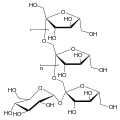Carbohydrate

Carbohydrates are chemical compounds that contain only oxygen, hydrogen and carbon. They are made up of joined-up sugars. Sugars have the general formula Cm(H2O)n, and are also known as saccharides.
Certain carbohydrates are an important storage and transport form of energy in most organisms, including plants and animals.
Biochemistry
There are four types of carbohydrates, named by the number of sugar molecules they contain.
- Simple saccharides with one or two sugar molecules
- Monosaccharides: single sugar e.g. glucose, fructose[1]
- Disaccharides: two saccharides. e.g. sucrose, lactose, maltose
- Longer chain saccharides:
- Oligosaccharides (shortish chains), often linked to amino acids or lipids. They play a special role in cell membranes.
- Polysaccharides (long chains) are complex carbohydrates, with linear chains of sugars or branched clusters. Their function is either energy storage (starch, glycogen) or building structures (cellulose, chitin).
Nutrition and foods
Carbohydrates are the most common source of energy for the human body. Protein builds tissue and cells in the body. Carbohydrates are very good for energy, but, if a person eats more than needed, the extra is changed into fat through a process called de novo lipogenesis.[2]
If necessary, humans can live without eating carbohydrates because the human body can change fats and proteins into carbohydrates through a process called gluconeogenesis.[3] Some already stored glucose in the liver can be released through another process called glycogenolysis. People of some cultures eat food with very little carbohydrates, but they still remain healthy, such as the Inuits.[4]
Research in the United States and Canada have shown that people get about 40% to 60% of their energy from carbohydrates (mostly from refined carbohydrates).[5] The amount of energy needs may depend on the amount of physical work done by people: the harder the work, the more energy they need. The other need for energy is body temperature. Living in a cold climate means a person needs more energy.[6]
Some foods (especially grains) have high levels of carbohydrates including wheat products (bread, pasta, potatoes, cereals), rice, etc.
Carbohydrate Media
Lactose is a disaccharide found in animal milk. It consists of a molecule of D-galactose and a molecule of D-glucose bonded by beta-1-4 glycosidic linkage.
D-glucose is an aldohexose with the formula (C·H2O)6. The red atoms highlight the aldehyde group and the blue atoms highlight the asymmetric center furthest from the aldehyde; because this -OH is on the right of the Fischer projection, this is a D sugar.
- Alpha-D-glucopyranose-2D-skeletal.png.
- Beta-D-glucopyranose-2D-skeletal.png.
Glucose can exist in both a straight-chain and ring form.
Sucrose, also known as table sugar, is a common disaccharide. It is composed of two monosaccharides: D-glucose (left) and D-fructose (right).
The structure of fructooligosaccharide
Grain products: rich sources of carbohydrates
References
- ↑ "Monosaccharides - an overview | ScienceDirect Topics". www.sciencedirect.com. Retrieved June 3, 2021.
- ↑ Ameer, Fatima; Scandiuzzi, Lisa; Hasnain, Shahida; Kalbacher, Hubert; Zaidi, Nousheen (July 1, 2014). "De novo lipogenesis in health and disease". Metabolism. 63 (7): 895–902. doi:10.1016/j.metabol.2014.04.003. ISSN 0026-0495. PMID 24814684.
- ↑ Manninen, Anssi H (December 31, 2004). "Metabolic Effects of the Very-Low-Carbohydrate Diets: Misunderstood "Villains" of Human Metabolism". Journal of the International Society of Sports Nutrition. 1 (2): 7–11. doi:10.1186/1550-2783-1-2-7. ISSN 1550-2783. PMC 2129159. PMID 18500949.
- ↑ Husten, Larry (July 29, 2016). "Changes In Eskimo Diet Linked To Increase In Heart Disease". CardioBrief. Retrieved May 7, 2021.
- ↑ "Americans Are Still Eating Too Many 'Bad' Carbs". WebMD. Retrieved May 7, 2021.
- ↑ Ocobock, Cara (December 2016). "Human energy expenditure, allocation, and interactions in natural temperate, hot, and cold environments". American Journal of Physical Anthropology. 161 (4): 667–675. doi:10.1002/ajpa.23071. ISSN 1096-8644. PMID 27561011.
| Wikimedia Commons has media related to Lua error in Module:Commons_link at line 62: attempt to index field 'wikibase' (a nil value).. |








